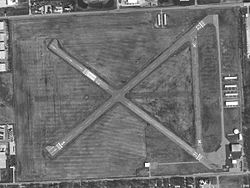Smith Field (Indiana) facts for kids
Quick facts for kids
Smith Field
|
|||||||||||||||||||||||
|---|---|---|---|---|---|---|---|---|---|---|---|---|---|---|---|---|---|---|---|---|---|---|---|

USGS aerial image, 6 April 1998
|
|||||||||||||||||||||||
| Summary | |||||||||||||||||||||||
| Airport type | Public | ||||||||||||||||||||||
| Owner/Operator | Fort Wayne Allen County Airport Authority | ||||||||||||||||||||||
| Serves | Fort Wayne, Indiana | ||||||||||||||||||||||
| Elevation AMSL | 835 ft / 255 m | ||||||||||||||||||||||
| Coordinates | 41°08′36″N 085°09′10″W / 41.14333°N 85.15278°W | ||||||||||||||||||||||
| Website | www.SMDairport.com | ||||||||||||||||||||||
| Runway | |||||||||||||||||||||||
|
|||||||||||||||||||||||
| Statistics (2007) | |||||||||||||||||||||||
|
|||||||||||||||||||||||
|
Source: Federal Aviation Administration
|
|||||||||||||||||||||||
|
Smith Field
|
|
| Location | 426 W. Ludwig Rd., Fort Wayne, Indiana |
|---|---|
| Area | 220 acres (89 ha) |
| Built | 1919 |
| Architect | A.K. Hofer; Walter D'Arcy Ryan |
| Architectural style | Aircraft Hangar |
| NRHP reference No. | 02001495 |
| Added to NRHP | March 26, 2003 |
Smith Field (IATA: SMD, ICAO: KSMD, FAA LID: SMD) is a public airport located north of Fort Wayne, Indiana. It is managed by the Fort Wayne Allen County Airport Authority. Smith Field is mainly used for general aviation, which means it's for private planes and smaller flights, not big passenger airlines. In 2002, this airport was added to the National Register of Historic Places.
Contents
History of Smith Field
Smith Field is Fort Wayne's very first city airport. It is also one of the oldest places in America where planes have been flying for a long time.
Early Days and Airmail
The United States government started a national airmail system in 1918. This helped new airline companies grow. On June 25, 1925, Fort Wayne officially opened this airfield as the Paul Baer Municipal Airport.
New paved runways and a large heated building called Hangar #2 were built. These improvements helped attract a company to carry mail by air to Fort Wayne in December 1930. Soon after, companies like Transamerican, Capitol Airways, and Trans Continental and Western (TWA) began offering passenger flights in the early 1930s. In 1932, almost 3,000 passengers used the old Paul Baer Municipal Airport.
Improvements During the Great Depression
During the Great Depression, the government started programs to create jobs. These programs helped improve the airport even more. In 1933, the Commerce Department and the Civil Works Administration (CWA) began a national airport improvement plan.
The CWA paid for thousands of hours of work at Baer Field in 1933. This work included fixing drainage, adding lights, planting grass, and improving parking areas. By 1934, the airport had better concrete runways. In 1935 and 1936, the Works Progress Administration (WPA) funded more concrete, better lighting, and new radio equipment. Old Baer Field was one of the biggest WPA projects in Indiana. During this time, the airport received over $311,000 for improvements from various government programs.
Famous Visitors
Many famous pilots have visited Smith Field over the years. These include "Wrong Way" Douglas Corrigan, General Jimmy Doolittle, stunt flyer Jimmie Hayslip, Walter Hinton, Howard Hughes, and Charles Lindbergh. Captain Charles Nungesser and fighter "Ace of Aces" Captain Eddie Rickenbacker also visited.
Captain Sir George Wilkins flew into the airport in the same plane he used to fly to the North Pole. The famous pilot and explorer Wiley Post also visited in his plane, the Lockheed Vega "Winnie Mae," which he flew around the world. When these famous aviators arrived, many people from Fort Wayne came to see them.
World War II and the Name Change
Before World War II, the U.S. War Department looked at airports for military use. In 1940, they considered Baer Field. City leaders bought land south of Fort Wayne in case the military needed a new airfield. In January 1941, the War Department said they would build a base in Fort Wayne if they could have the land by February 1. Local business people helped raise the money to buy the land.
The War Department leased the new land for $1 a year. They asked the community for name ideas. People suggested "General Anthony Wayne Field" and "Smith Field," honoring Fort Wayne native Arthur "Art" Smith. The Army Air Corps usually named airfields after military pilots who had passed away. So, they decided to name the new Army airfield (south of town) after Paul Baer. The existing municipal airport was then renamed Smith Field after Art Smith.
The new "Baer Field" (now Fort Wayne International Airport) officially became an Army base on June 14, 1941. On December 6, 1941, the day before the attack on Pearl Harbor, 31 P-39 Airacobra fighter planes arrived. Soon, up to 100 of these planes were stationed there. The old Baer Field, now called Smith Field, continued to serve as Fort Wayne's civil airport during World War II and has been used for general aviation ever since.
Modern Airport Activities
In 2010, Runway 5/23 at Smith Field was rebuilt. The airport offers flying lessons and plane rentals through a company called Sweet Aviation. Sweet Aviation is part of Sweetwater Sound.
Airport Facilities and Aircraft
Smith Field covers about 234 acres. It is 835 feet (255 meters) above sea level. The airport has two asphalt runways. Runway 5/23 is 3,124 feet (952 meters) long and 60 feet (18 meters) wide. Runway 13/31 is 2,922 feet (891 meters) long and 100 feet (30 meters) wide.
In 2007, there were 20,109 aircraft operations at the airport. This means about 55 planes took off or landed each day. Almost all of these were general aviation flights. At that time, 56 aircraft were based at Smith Field. Most of these were single-engine planes.
- FAA Terminal Procedures for SMD, effective 15 December 2011
- Resources for this airport:
- FAA airport information for SMD
- AirNav airport information for SMD
- ASN accident history for SMD
- FlightAware airport information and live flight tracker
- SkyVector aeronautical chart for SMD



